
|   |

|   |
 e-mail: sunilkothari1933@gmail.com Rasa Rangini Dance Festival Photos courtesy: Debnrutyam August 4, 2018 Under the aegis of his Debnrutyam Studio, Debasish Pattnaik, a disciple of Durga Charan Ranbir, dividing his time between Rourkela, Moscow and Bangalore, organizes a three- day festival every year in Bangalore titled Rasa Rangini. Durga Charan Ranbir is a disciple of late Guru Deba Prasad Das, whose gharana he maintains faithfully, investing imagination to his choreographic works. So does young Debasish Pattnaik. He has a sizable number of students and it seems that local Odiya community also supports his efforts to popularize Odissi in Bangalore. When I was coming from airport, Debasish's colleague Abinash Mishra informed me that as per last count, the number of Odiyas settled in Bangalore has crossed 10 lakh and that number is increasing as more and more unemployed Odiyas come to Bangalore for jobs, be it in IT sector or service sector, in hotels, and for other jobs. Those who have made it big are fond of Odissi dance and promote it. Debasish is lucky to receive support from his well-wishers and is able to mount the festival. In the three day festival, the first day was devoted to Mancha Pravesh of his student from Rourkela, well trained and showing promise to turn into a good performer. Meghna Mishra looked mature for her age. She is tall and belies her age as a fourteen year old. Learning from age of seven, she has shown enough promise, with sound training. She has good looks and stage presence. The repertoire with Kali Mangalacharan in raga Pahadi and Malkauns, set to ektali interspersed with sabdaswarapata was pleasant. Sthayee in Sankarabharanam raga and ektali tala is a de rigueur number of Deba Prasad Das style that gives one a flavour of the gharana.The melodious Mohane deli chahi go in raga Kirvani and jati tala evokes nostalgia. As abhinaya pada of Banamali, Meghna performed with appropriate expressions though it was replete with charming innocence. Basant raga Pallavi followed by Gita Govinda ashtapadi Sanchara dadhara sudha madhura dhwani in Mishra Kafi raga and jati tala was rather ambitious for young Meghna to do justice to portray Radha's agony. It should be presented when she reaches a mature age. Ashtashambhu in Malkauns and tala triputa, choreographed by Deba Prasad Das, re-choreographed by Debasish gave Meghna scope for displaying varying moods. It is one of the finest choreographic works of Deba Prasad Das. With maturity, Meghna would be able to perform it with more grasp. The seasoned team of musicians Sukanta Kumar Kundu on vocal, Abhiram Nanda on flute, Pradeep Kumar Rath on violin and Niranjan Patra on mardala also reciting ukutas - mnemonic syllables - along with Debasish who played manjira, gave Meghna very good support. Live music lends extra dimension to dance in comparison with recorded music. Debasish impressed one and all about his role of a guru, even though he looks young. One hopes Meghna will continue to dance and fulfill the promise she has shown. 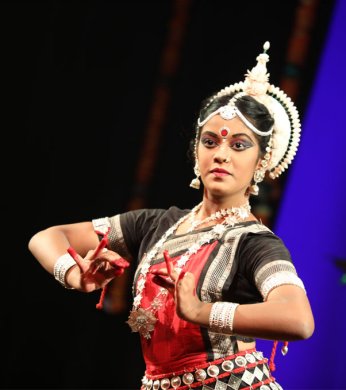 Meghna Mishra 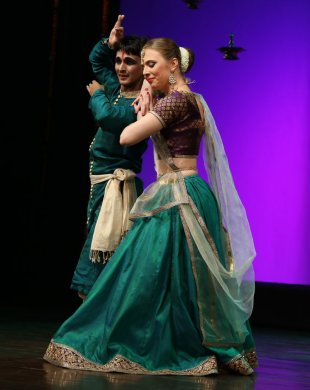 Pankaj & Polina The second day of the festival was named Milita Utsav as Debasish presented jugalbandi of international artists. Opening with Kathak duet by Russian dancer Polina Lavrushikina from Moscow and Pankaj Rawat from Delhi, disciples of Guru Munna Shukla of Lucknow gharana, both matched each other in executing infra forms of Kathak like tode, tukde, paran, tatkar gracefully showing their hard work in mastering beauty of Lucknow gharana. There were delicate movements along with chakkars, and in tatkar, commendable control. It was interesting to see different classical dance forms performed in one evening showcasing dancers from other countries. It also is interesting to note that the non-Indians work hard and display deep interest in an alien culture. Ranjana Gauhar is a name to reckon with in Odissi as a senior performer, a disciple of Guru Mayadhar Raut. Seasoned exponent as she is, her abhinaya to ashtapadi from Gita Govinda, Rati sukha sare was enchanting and mature. In the ashtapadi, Radha's confidante tells Radha not to delay and go and be united with Lord Krishna who awaits her preparing a bed of flowers and looking in all directions for her arrival. Mayadhar Raut's choreography is different from Guru Kelucharan Mohapatra. It was interesting to see subtle interpretations for depiction of Krishna's anxiety. Mayadhar Raut approaches more on the literal text with hastabhinaya to depict Krishna's preparing bed and waiting for Radha. Ranjana with her own maturity adds intensity that makes the ashtapadi more enjoyable. There is an authoritative persuasion in directing Radha to go and be with Krishna. Of course, the poetry of Jayadeva with sakhi's suggestions to Radha to put on lovely sari and leave ankle bells, tyaja manjiram, enemies of union, ripumiva keli sulolam, are enacted with joy. Ranjana's graceful movements with delicate footwork and emotive expressions invests her performance with visual poetry. 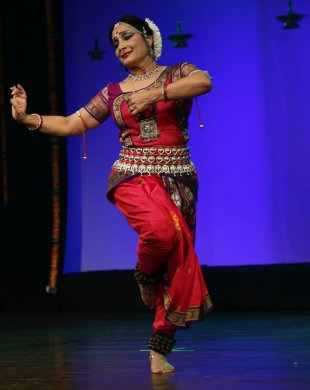 Ranjana Gauhar 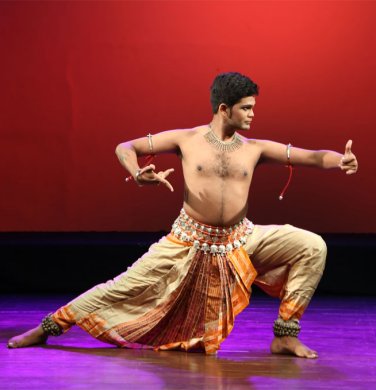 Vinod Kevin Bachan Her student Vinod Kevin Bachan from West Indies studying under her for past five years after having studied under different gurus in Bhubaneswar for five years, has assimilated Ranjana's style and choreography in his dance. He is tall, graceful, has sound footwork, good command over tala and projects expressions convincingly. Ten years of pursuing his passion has earned him dividends. Ranjana choreographed for him Swati Tirunal's Chalo man tum Kashi Vishweshwar darshan ko. She elaborated upon Shiva's form holding trishul, ear ornaments with serpents, body glowing with ashes and as a devotee, Vinod when he sees the magnificent form of Lord Shiva, is overwhelmed. He sees the lord whose consort Girija is his half body, ardhangini. Such touches in choreography were noteworthy. The overall look with his height, arms and solid footwork, Vinod Kevin impresses with his movements, but he would do well to develop tandava movements when dancing as Lord Shiva. The final pose with vrischik karana, with bend of one leg locked up in arm and standing rock steady on one foot showed his strength. With his passion to stay and perform in India, he is bound to go places. Rekha Satish, a disciple of Manju Bhargavee in Kuchipudi, and Sujay Shanbag, a disciple of Rashmi Doraswamy from Mysore in Bharatanatyam, presented in their respective styles a varnam composed by Srivatsa on theme of Ganga Gaman, Ganga's descent on earth to release sons of Bhagiratha from the curse of having shot arrows on the Rishi in penance. The episodes were performed in quick succession with Úlan and in scintillating tempo. Sujay Shanbag impressed one for his sound training and perfection. He has a star quality. One comes across many male dancers of high standard in Bangalore, and such compositions and choreographic works suit the male and female performances. In terms of nritta, both did commendable job dancing alternatively with clarity and sparkle. The Vamanavatara highlighting Ganga's flowing from the lord's feet, the flowing of Ganga from jata of Lord Shiva, their duet dance et al were full of vigor and charm. What one was intrigued was at choice of aharya, the costumes which could have been better designed when there is such wealth of material. Since aharya is an important element of abhinaya, in a visual art, it matters a lot. I am sure they would make good selection for future performances. 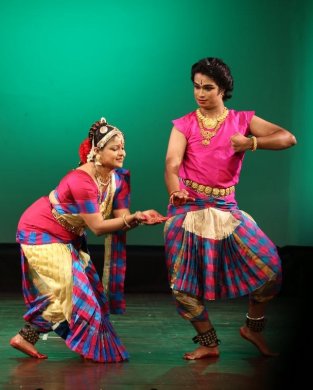 Rekha Satish & Sujay Shanbag 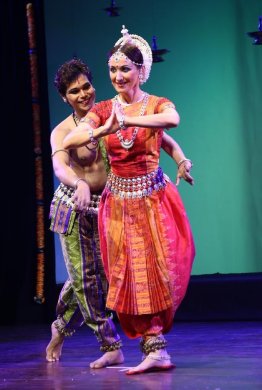 Debasish & Elena Debasish and his disciple from Moscow, Elena Kynazeva in their duet of Adi Shankaracharya's Ardhanarishwara choreographed by Debasish, explored the various forms and attributes of Lord Shiva and Parvati. Adorned with silken garments Parvati exudes divine beauty, whereas Lord Shiva with vyaghracharma and even as digambara, directions as his clothes, garlands of Mandar flowers adorn Parvati, whereas garlands of skulls adorn Lord Shiva, and so on created different images, which were further embellished with sabdaswarapata recitation replete with quicksilver movements. Sabdaswarapata lends extra texture to music, rhythm and movements. It is a salient feature of Deba Prasad style and is highly enjoyable. Elena, I was told, had studied Guru Kelucharan Mohapatra's style for a decade under Sujata Mohapatra. But after seeing Debasish's style she switched over to Deba Prasad's style. The transition has been smooth. As a matter of fact, it has helped her acquire the style easily. Both Debasish and Elena's dancing was in perfect sync. The way they stood covering their bodies giving an illusion of half bodies, ardhangas, was quite imaginative. It was part merging and yet distinctly visible. Debasish's sense of choreography is praiseworthy.
The third day of Rasa Rangini featured Contemporary dance of Compania de Danza Periferia by six dancers from Columbia who are touring India and were presented by Indian Council for Cultural Relations under the scheme of cultural exchange. In/Movil, the title of the choreographic work was quite in contrast with our Indian classical dances and presentation. It had several political overtones. Despite several hurdles, the subject and population of Columbia would rise again and would not give in to depression and despair. The two groups using two tables as props confronted each other keeping two tables in opposite directions. The dancers often jumped on the tables. They brought them together as one platform, then separated them, then placed with their flat base like a wall, and came out of that wall and proclaimed as free, raised their fists and showed that they are free. The work explored what happens to the will in face of a tragic event and about mobilizing and confronting the tragic. The Columbian contemporary dance was followed by Indian classical dances with Debnrutyam Studio dancers' Jagannatha ashtakam by Adi Shankaracharya choreographed by Debasish with lot of imagination. He and two more male dancers Shrikant Das and Rohit SH, and three female disciples Anushka Mohanty, Sheetal Mohanty and Sanskruti Mishra wove images of Jagannatha, Subhadra in the middle and Balabhadra on other side, the way the three deities are seen in Puri temple. The male dancers took roles of the two male deities and Subhadra's role was taken by a female dancer. The rest of the group took roles of devotees praying to the gods. The way they turned into the three images and then performing as devotees moving in circle was smooth transition from a temple to the section of devotees. The choreography was conceived in a seamless manner, with the sequences flowing harmoniously. The pulling of the chariot, and description of the gods in Sanskrit shlokas of Jagannatha ashtakam were visualized in dance sometimes graphically and sometimes with suggestion. Debasish once again performed Ardhanarishwara with Elena Kynazeva, which he could have replaced with a new choreographic work.  Debasish & group 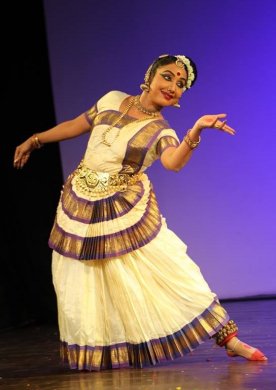 Neena Prasad The most engaging number was a varnam in Mohiniattam by that ace performer from Thiruvanathapuram, Neena Prasad. An accomplished dancer with a Ph. D in dance from Rabindra Bharati University, Kolkata, and well-versed in classical Carnatic music and also Bharatanatyam, Kathakali and Kuchipudi, Neena has created her own niche in Mohiniattam. The opening number Cholkettu consisting of stylized rhythmic syllables in tune with raga was rendered with alluring grace. Neena explained briefly how from Bilahari raga shifting to closer raga in Sankarabharanam she had with help from Madhavan Nambudri, cast the pada varnam in Mohiniattam. She had explored the theme of six vices weaving story of Lord Rama that she had read from Rajasthani Amar Katha. To remove ego, Lord Rama asked Hanuman to test Arjuna who was doing penance. Mockingly, he asked even monkeys built the sethu - the bridge on ocean connecting Sri Lanka - can he achieve such a feat? Arjuna shot arrows after arrows and built bridge of arrows. Hanuman laughed and with one stroke by him the bridge collapsed. Arjuna was mortified. Once again, removing his ego he built the bridge with arrows praying to Lord Rama and the bridge did not collapse. Thus Lord Rama helped Arjuna give up his ego. Similarly, incomparable in beauty, vain Kamadeva was taught a lesson by Rama when he appeared in full glory before Kamadeva. Seeing shape of Rama's eyebrows, his neck in shape of a conch, his arms and personality, Kamadeva was completely aghast and realized that his beauty was nothing before that of Lord Rama and he bowed to the lord giving up his ego. Seeing the beauty of Gautami, Indra who was enamoured with lust, was taught a lesson. When Rishi Gautama went for morning bath to the river, Indra took form of Gautama and ravished Ahalya. Rishi on learning of it cursed her and she turned into stone. (There is an aside to this event that Indra was turned into a bird with hundred eyes!). It was Lord Rama whose feet touched her form in stone, and she gained her mortal form and achieved salvation. The devotion to Lord Rama absolves all sins. These sanchari bhavas were enacted with great artistry that left an indelible impression on the audience. Neena abbreviated the theme dealing with ego and lust. She did not elaborate upon other vices. The selection of such themes from mythology in Mohiniattam dance pushes the boundaries of the form. It does not remain a mere expression of enchantress. It transcends it and reveals its potential to enlarge its scope dramatically. Swati Tirunal's pada in Mishra Pahadi raga and mishra chapu tala, Aaj aye Shyam Mohan rasa mandal khelane - Lord Krishna has come to play Rasalila - was delineated by Neena with charm, portraying Krishna, guilty for breaking pots, and when chided by Gopis, with face cast low, shedding tears, melting hearts and Gopis forgive him and embrace him. Her visage wore expressions in a fleeting manner registering emotions that were endearing. The Rasalila, Krishna playing with sticks, Dandarasaka, striking sticks with Gopis created an illusion of several Gopis with whom Krishna was dancing. An ability to create such artistic illusions helps Neena to perform with complete involvement in whatever she performs. In the finale with Vande Mataram, a poem in Malayalam language, Neena visualized the motherland full of richness and beauty. The prayer was moving and shared by the captive audience. Her Mohiniattam was further embellished by Madhavan Nambudri's soulful singing, Prateesh Kumar's violin and Chandrakumar's excellent mridangam accompaniment. One missed the sound of edakka which invariably enhances the beauty of a Mohiniattam recital. Neena deserves encomiums for such a memorable performance.
The final presentation of Kathak in a group dance by husband and wife, dancing duo Hari and Chethana and their troupe created excitement with the scintillating footwork and graceful chakkars. Hari dressed in a flaring blue angarkha and Chethana and the three dancers in saffron coloured saris and blue scarves filled up the stage with eye-catching visuals. Their repertoire full of mnemonic syllables and musical refrain won rounds of applause with their graceful endings. Tihais, moving in circles, others moving away, Hari and Chethana performing various footwork including ginati and arriving on final sam, were quite captivating. For abhinaya, they chose Vallabhacharya's Madhurashtakam. In the beginning only Hari described the beauty of lips, eyebrows, smile of Krishna, offered prayer, arati, chandan, flowers and Chethana joined him further describing Krishna's graceful walk, his visage, eyes, and then other dancers joined to create a visual of Krishna playing with Gopis. They moved in circle, covering the stage, their skirts whirling along with them creating attractive visuals. Their dancing with complete involvement was pleasing to the eyes. The recorded music, with alaap was melodious. They drew a large audience as they have a steady following of their admirers, who displayed their admiration by clapping as is practice in Kathak. The three day dance festival thus came to an end. It was obvious that Debasish and his colleagues Abinash Mishra, Shreelekha Sunil, J.V Samath and others had worked hard to mount the productions. Compering by Swapna Rajendrakumar, herself a noted Mohiniattan dancer trained by Sunanda Nair, was pleasant giving in brief, introductions of artists and items. What one finds in such presentations are the unnecessary decorations of stage props, releasing smoke, which is irritating and inartistic. Simple bare background helps dance to come into its own. The extra elements take away from the intrinsic qualities of dance. One appreciated devotion and respect shown to invited guests and dignitaries. But to honour some of them attending three days is unnecessary and time consuming. This practice must be discontinued. Giving mementoes daily with shawls and flowers is unnecessary. Today, the professional presentation dispenses with such formalities. Not only Debasish but other dancers in Bangalore also need to dispense with such formalities to achieve professional etiquette. The printed material about Debnrutyam institution and participating artists was well documented. In order to present Guru Deba Prasad style, Debasish needs to branch out in other major cities, go and meet the organizers, institutions and artists who he presents and get known. He should also concentrate on training two or three gifted disciples to represent his style. That will help him build up his career as a guru and also as a performer and gifted choreographer.  Dr. Sunil Kothari is a dance historian, scholar, author and critic, Padma Shri awardee and fellow, Sangeet Natak Akademi. Dance Critics' Association, New York, has honoured him with Lifetime Achievement award. Post your comments Please provide your name and email id when you use the Anonymous profile in the blog to post a comment. All appropriate comments posted with name & email id in the blog will also be featured in the site. |